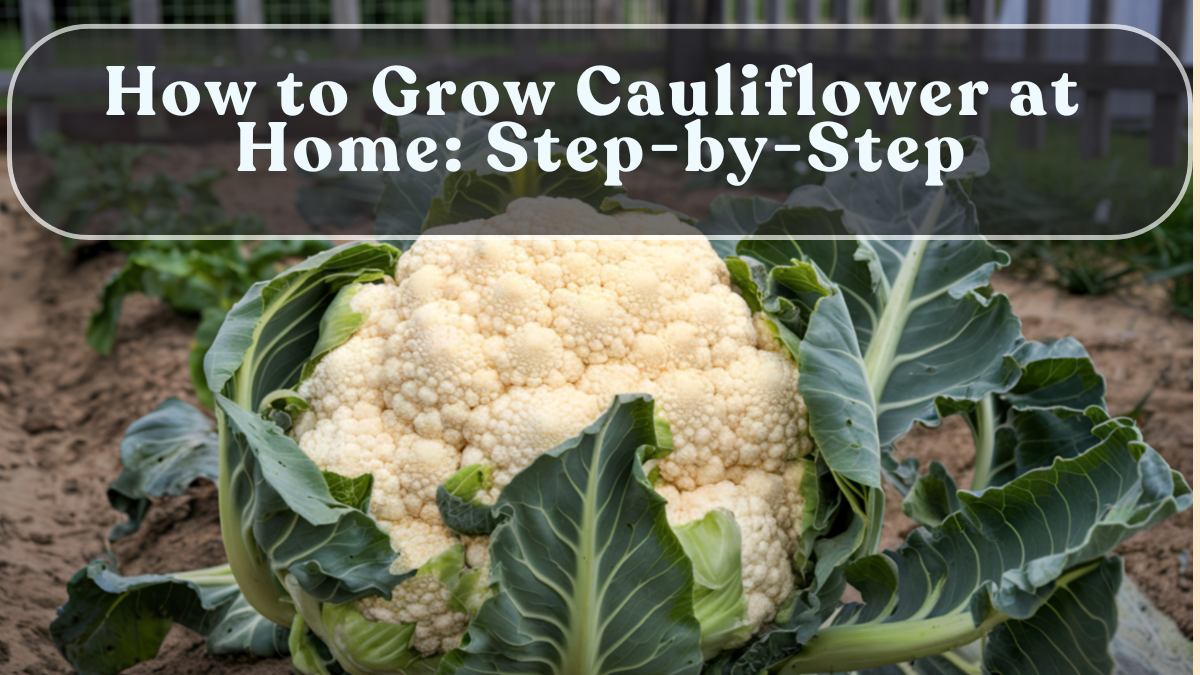Growing cauliflower at home can be incredibly satisfying—especially when you harvest those firm, white heads straight from your own garden. Cauliflower is a cool-season crop that thrives during the winter months and grows beautifully in containers or small backyard beds. By following a few simple organic methods, you can enjoy fresh, chemical-free cauliflowers with perfect texture and taste.

Ideal Conditions for Growing Cauliflower
Cauliflower prefers cool temperatures between 15°C and 25°C and grows best during late autumn to early spring. It’s sensitive to both excessive heat and frost, so timing your planting is key.
Choose a location that gets at least 5–6 hours of sunlight daily and has well-draining, fertile soil. Shade nets can be used in warmer climates to protect tender seedlings.
Choosing the Right Variety and Soil
For home gardening, choose fast-growing and compact varieties like Pusa Snowball, Early Kunwari, or Himalaya 24. These are resilient and mature within 75–90 days.
Prepare a rich, organic soil mix as follows:
-
40% garden soil
-
30% compost or cow dung manure
-
20% cocopeat
-
10% sand or perlite
Maintain soil pH between 6.0–7.5. Before planting, add wood ash or bone meal to improve calcium and phosphorus levels—essential for tight, firm curds.
Sowing and Transplanting
Cauliflower can be grown from seeds or seedlings.
-
Seed sowing: Sow seeds ½ inch deep in seed trays or small pots. Keep them moist until germination, which occurs within 6–8 days.
-
Transplanting: Move seedlings when they are 4–5 weeks old and have 4 true leaves.
-
Spacing: Keep 18–20 inches between plants and 2 feet between rows for good air circulation.
After transplanting, water thoroughly and provide partial shade for 2–3 days to help plants settle.
Watering and Feeding
Water the plants 2–3 times a week, ensuring consistent moisture but avoiding waterlogging. Uneven watering can cause loose or uneven curd formation.
For feeding:
-
Apply organic compost or vermicompost every 15 days.
-
Use liquid seaweed extract or compost tea for added nutrients.
-
Avoid high-nitrogen fertilizers, which cause leafy growth instead of curd formation.
Mulching with dry leaves or straw helps retain moisture and control weeds.
Pest and Disease Management
Common cauliflower pests include aphids, cabbage worms, and flea beetles. To control them:
-
Spray neem oil solution (5 ml per liter of water) weekly.
-
Use garlic or chili extract sprays as a natural repellent.
-
Rotate crops annually to prevent soil-borne diseases like clubroot or damping-off.
Ensure good airflow between plants and avoid overcrowding to minimize fungal infections.
Blanching for White Heads
Blanching helps maintain the curd’s white color and tender texture. When the curd starts forming (about the size of a golf ball):
-
Tie the outer leaves loosely over the developing head using a soft thread or rubber band.
-
Keep it covered for 7–10 days until maturity.
This simple trick prevents sunlight exposure and keeps the cauliflower crisp and bright.
Harvesting
Cauliflower is ready for harvest 70–90 days after transplanting when the heads are compact, white, and firm.
Cut the curd along with a few surrounding leaves for protection. Avoid delaying harvest, as overripe heads become loose and yellowish.
After harvesting, wash gently and store in a cool, dry place or refrigerator to keep fresh for up to 7 days.
Conclusion
Growing cauliflower at home is easier than it looks when you follow proper timing, soil care, and pest management. With organic compost, regular watering, and blanching, you’ll get dense, healthy heads full of flavor.
It’s a perfect winter vegetable for both beginners and experienced gardeners—rewarding your patience with a nutritious, homegrown harvest straight from your own balcony or backyard.
FAQs
How long does cauliflower take to grow?
Cauliflower takes about 70–90 days from transplanting to harvest, depending on the variety.
Why are my cauliflower heads loose?
Loose heads result from temperature stress or inconsistent watering—keep soil evenly moist and cool.
Can I grow cauliflower in pots?
Yes, use 12–14 inch deep containers with nutrient-rich organic soil and proper sunlight.
What is blanching in cauliflower growing?
Blanching means tying leaves over the curd to protect it from sunlight and keep it white.
When should I plant cauliflower?
Sow seeds in late autumn or early winter for best results in cool climates.
